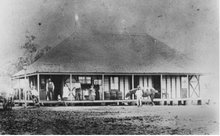When I tell people that we’re working on a book on mining in the Rosewood-Marburg area, everyone thinks first of the New Oakleigh mine on the Rosewood side of Tallegalla. It’s not huge by Queensland mining standards, but in a rural landscape of farms, hills, fields and scattered houses, an open-cut coal operation is noticeable. All day coal trucks rumble down the main street of Rosewood, taking coal to Swanbank power station. Coal trains haul their loads through Rosewood from the same company’s mine in Oakey. I sometimes think that the existence of Rosewood is a blot on the mining company’s landscape. After all, the trucks have to slow down to a crawl through town, the freight trains compete with the commuter train – all in all an inconvenience. And pesky people keep complaining about dust, noise and scenic pollution.
No, the coal mines in which we are interested are the family ones. Ones where the farmer would milk the cows, do the farm jobs, go down the mines for a few hours, then milk the cows again. Some of the mines were big enough for several people to work there, but some were simply family operations. Coal was put on the train and taken into town for sale. Sometimes people had individual contracts supplying a couple of bags of coal a week to local hospitals or businesses. One story is told of how during the mining strike of the 1930s, Rosewood and Marburg coal kept people and industry in south-east Queensland going. Private coalmines weren’t unionised and were the only ones that could keep going. And according to my colleague, that’s how we know coal is black, because it was so declared by the unions.
The book that we envisage is based on oral histories of these small coalmines and the “lived experiences” of miners and their families. We want to hear about the experiences of working down the mines, of conditions, how the coal was extracted, where it was sold, where the mines actually were, who worked there, how long, what it was like being married to a miner, how wives and mothers got mining clothes clean, whether people got injured and how, when did people’s children start working in the mines, what people liked and disliked about mining, when they stopped mining, what happened to the mines…
We’ve been warned that such oral histories are asking for trouble. After all, everyone has different perceptions so how can you write about what really happened? I don’t think I’ve told my collaborators yet that I don’t really believe that a contemporary person can get at historical truth or that such “truth” exists. A historian can write about the bare bones of events, but even these skeletons can be a matter of conjecture and assumptions (both historical and contemporary). All “truths” are based on interpretation and filtered through individual experiences and understandings. What a historian can do is to present these understandings and seek to tell a story on several levels.
One level is that of an individual’s understanding of what happened. This can be set into the context of public stories being told in news reports and contemporaneous publications. This in turn can be set into the context of modern understandings – the perspective that is gained from time having passed. At no point, as someone trained as a historian and as a professional communicator, would I feel comfortable claiming truth.
This doesn’t mean that everyone’s stories are equally valid. There are good and bad observers and people whose perceptions of events are clouded more heavily by their own experiences. And there are purposeful distortions and manipulations at all levels of society. It’s the job of the historian to sort through all of these and draw together ideas and thoughts into some kind of cohesion.
I’m looking forward to hearing these stories. If you or anyone you know have stories about mining in this area, please do feel free to contact me through the blog, or through my email. We’ll be in touch.
Tuesday, 19 May 2009
Subscribe to:
Post Comments (Atom)

No comments:
Post a Comment